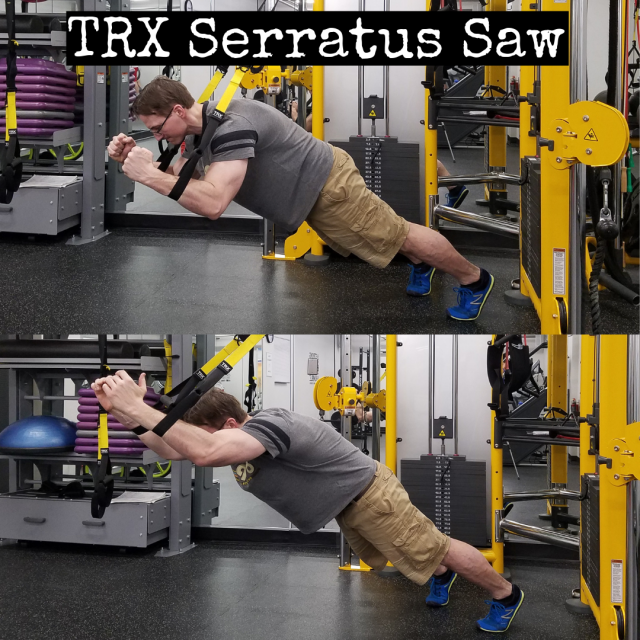 TRX Serratus Saw
TRX Serratus Saw
In the world of underappreciated muscles the serratus anterior is basically at the top of the list.
What’s a Serratus Anterior Do?
“The function of the serratus anterior muscle is to allow the forward rotation of the arm and to pull the scapula forward and around the rib cage. The scapula is able to move laterally due to the serratus anterior muscle, which is vital for the elevation of the arm. The serratus anterior muscle also allows the upward rotation of the arm, which allows a person to lift items over their head. When the shoulder blade is in fixed position , e.g : breathing after a sprint , the serratus anterior lifts the ribcage and thus supports breathing.”- Physiopedia
Yes, when you move the arm forward, like in a punch the scapula should move FORWARD and AROUND the rib cage.
Almost like the scapula is hugging the ribcage as the arm moves forward.
*Keep in mind this is DIFFERENT than a bench press, where the scapula should remain in a “packed” position, fully retracted (pinched) tightly.
Moving the Arm Overhead?
The serratus anterior plays a major role in UPWARD rotation of the scapula.
This often gets confused with scapula ELEVATION..ie, MOVING the scapula upward, toward the ear, like in a shrug.
Upward rotation of the scapula is the motion of the scapula ROTATING upward, about a “fixed” point.
skip to 2:05 in the video for the serratus anterior role in scapular upward rotation.
Bro, Your Serratus Is Looking Good, Bro?
Without a strong serratus anterior you’re at risk for scapula dyskinesis.
Which is nerd speak for,
“Yo Sh@t is Broke as F”
And when you have scapular dyskinesis you’re at a greater risk for the dreaded
SHOULDER IMPINGEMENT
Which is really a lazy “throw away” term. <—-it doesn’t really define specifically how/ what’s going on.
All impingement means is that the soft tissues are being pinched between hard surfaces.
And shoulder impingement is exactly what happens when the scapula (shoulder-blade) doesn’t get out-of-the-way of the humerus (upper arm bone) when you lift your arm,
“Studies have demonstrated that subjects with shoulder impingement may present with decreased scapular upward rotation and posterior tilt, and increased scapular internal rotation during arm elevation.” – Scapular and rotator cuff muscle activity during arm elevation: A review of normal function and alterations with shoulder impingement
And what muscle prevents shoulder impingement by getting the scapula the F- out-of-the-way during arm elevation???
“The middle and lower serratus anterior are aligned with a substantial mechanical advantage for scapular upward rotation, in combination with the ability to posteriorly tilt and externally rotate the scapula. Hence the middle and lower serratus anterior muscles have been most often described as the prime mover for scapular rotation during arm elevation. The upper serratus anterior has been minimally investigated. The middle and lower serratus anterior are the only scapulothoracic muscles with the capability to both upwardly rotate and posteriorly tilt the scapula on the thorax. Their line of action will also directly approximate the scapula to the thorax, which can serve as a stable base. The functions of serratus anterior make its contribution to normal scapular kinematics during arm elevation very significant in reducing risk for scapular alterations identified with shoulder impingement symptoms, including reduced upward rotation or posterior tilting, or increased scapular internal rotation.” – Same study as above
So, you’re gonna want some serratus anterior.
You need some serratus anterior.
What’s a good way to get some serratus anterior?
TRX Serratus Saw
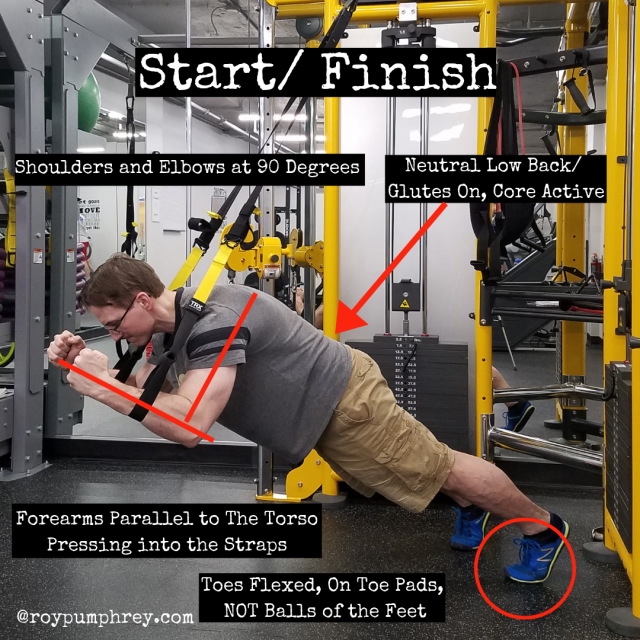
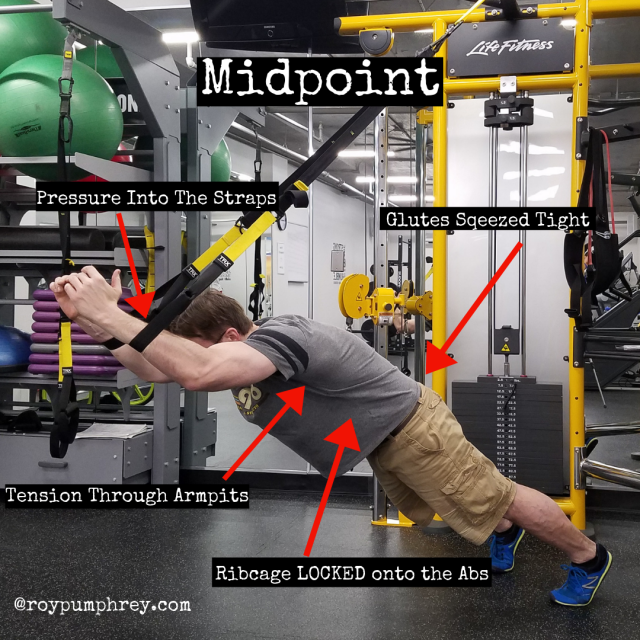
This is also a BOSS core, anti-extension, exercise.
Checklist:
- Forearms in the TRX straps, pressing into the straps.
- Elbows and Forearms at 90 degrees to start.
- Bottom rib down, glutes on (pelvis neutral).
- Toes flexed, on the toe pads, NOT the balls of the feet.
- Press the hands out pushing into the straps and never allowing the core to break/ hips to fall).
- PULL the hands/ elbows in from the lats and elbows never passing 90 degrees (maintaining tension).
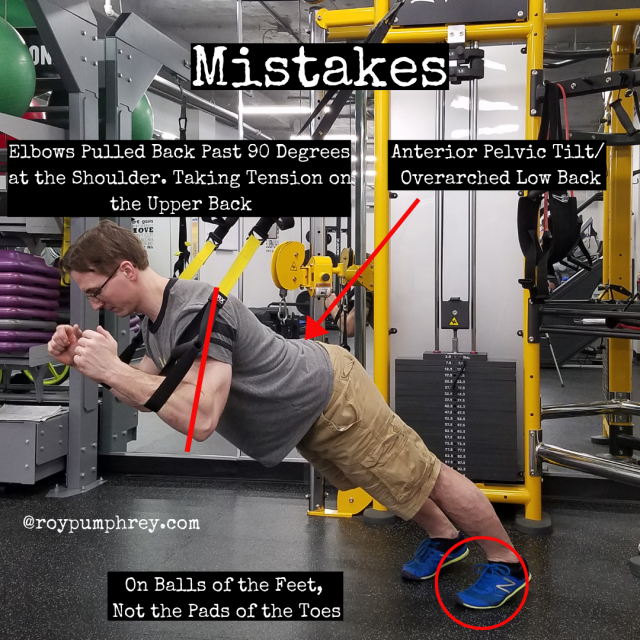
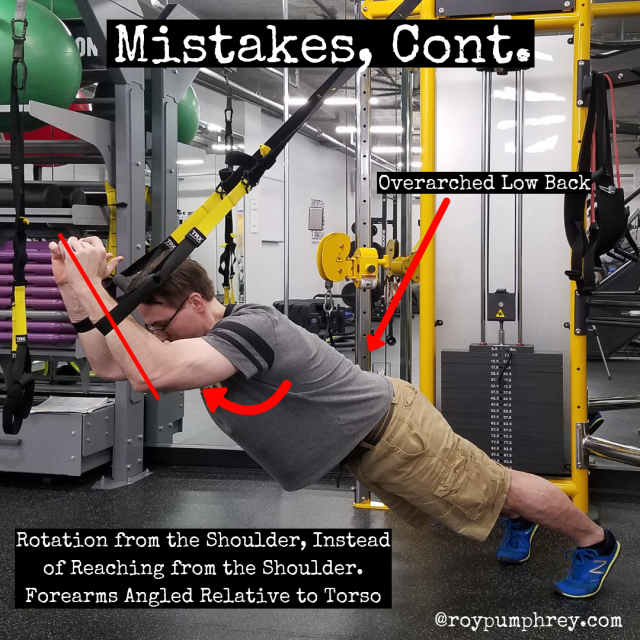
Bro tips:
- A slightly rounded thoracic spine is fine.
- KEEP THE FOREARMS PARALLEL TO THE TORSO THE WHOLE TIME
- When reaching out, taking a slight outward arc may allow for a smoother motion than reaching straight out.
- Squeeze your glutes HARD the whole time to maintain the pelvic position.
- Keep the chin/ head “down”. In neutral. Lifting the head almost always leads to anterior pelvic tilt.
- Only reach as far as you can maintain tension. More reach isn’t better if you’re just hanging on the straps, shoulders and low back.


